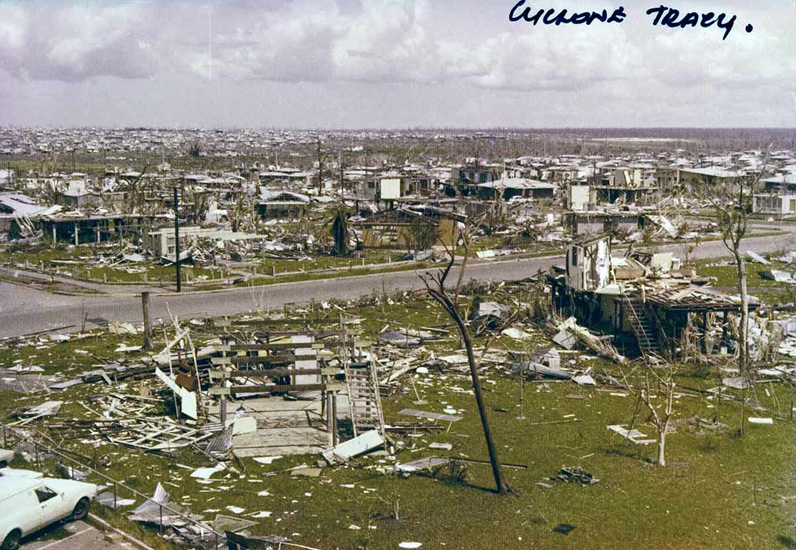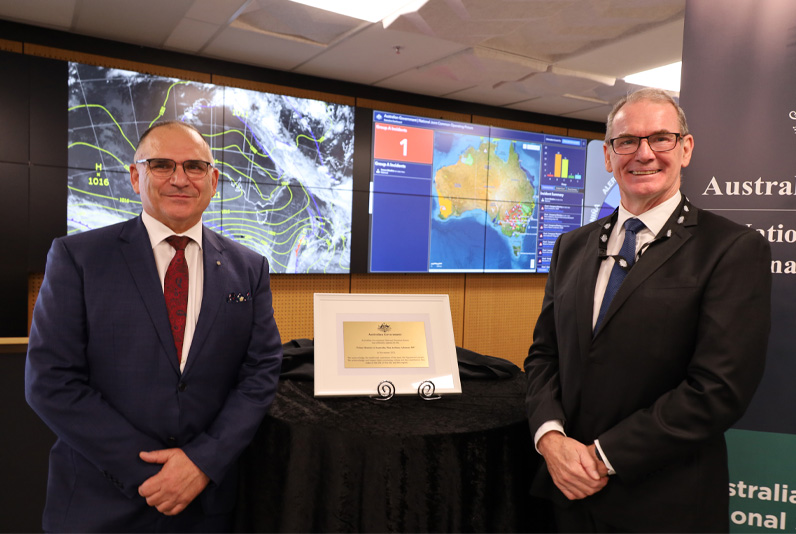Christmas morning is a time to spend with loved ones, a chance to acknowledge and thank each other and for many children to open presents. However, on Christmas Day 1974, residents of Australia’s top end faced the immediate and devastating aftermath of Cyclone Tracy.
This was not the first cyclone to hit Darwin. But this cyclone, and the damage it brought with it, was different as it was one of the most destructive in Australia’s history. Tragically, 71 people were killed and over 600 were injured. The cyclone also decimated the area of Darwin, destroying 5,000 homes and countless small businesses.
Christmas of 1974 became a time where, rather than families celebrating together and unpacking presents, they were packing up their belongings and leaving what was left of their homes and working out what came next.
At that time, Major-General Sir Alan Stretton CBE, AO, was head of the Australian Government Natural Disasters Organisation and he oversaw the evacuation of most of Darwin's population. This occurred, in large part, through the use of both military and civilian aircrafts.
This year marks 50 years since Cyclone Tracy and the establishment of Australia’s first national emergency organisation.
Creation of the first national emergency organisation
Cyclone Tracy was not the only disaster to occur in 1974. Brisbane also experienced devastating flooding in January of that year. This was brought on by the above-average rainfall across Australia during 1973.

The Darwin suburb of Wagaman was flattened during the cyclone.
Image: National Museum of Australia
The effects of these floods was widespread, including damage to roads, railways, power lines and bridges. The consequences from this event were felt in many ways, including to community connectivity, local economies as well as by first responders.
The events of 1974 highlighted the lack of national coordination for response to and recovery from large-scale disasters. The Australian Government understood that it was not just the immediate damage caused that needed action, but also that people were exposed to hazards following the event. These included hazardous materials, lack of access to clean water and supplies, limited shelter as well as places to safely keep their belongings.
The Australian Government established a body to help the states and territories after extreme events that would support coordination, increase stability, provide funding and consider mitigation for future hazards. The Cabinet created the Natural Disasters Organisation in February 1974 and Major-General Stretton was chosen to lead the organisation due to his wide military experience in World War II, Korea, Malaysia and Vietnam. The organisation was formed within the Department of Defence.
The new agency was initially staffed with 15 people to manage large-scale disasters. The early days was a period of determining a mandate and finding ways to work within existing systems. Only a few months after its establishment, the agency was activated in response to the destruction caused by Cyclone Tracy. It became clear that the organisation was going to be needed on an ongoing basis to support states and territories. This was the beginning of the relationship between Australian governments to improve ways to manage emergencies.
Establishing the Darwin Reconstruction Commission
In February 1975, the Australian Government established the Darwin Reconstruction Commission (DRC) to reconstruct Darwin with the aim of completion within 5 years. This was part of Prime Minister Gough Whitlam’s pledge to make ‘a determined and unremitting effort to rebuild your city and relieve suffering’. The DRC achieved its goal in fewer than 3 years; an amazing feat considering the extent of the devastation.
While Darwin is a thriving city today, the legacy of Cyclone Tracy remains in the collective memory of those who experienced the event and those who have lived there, or visited, in the decades since.
Continuing the legacy of national emergency management
The Natural Disasters Organisation continued within the Department of Defence until December 1992. It then transferred to the Attorney-General’s Department portfolio as Emergency Management Australia (EMA). It was formed primarily to manage severe bushfire-related events and the post-disaster recovery period. The first Director-General of EMA was Commodore Clem Littleton AO RAN.
At the time, EMA was the Australia’s primary emergency management agency. It provided national leadership in emergency management that helped to reduce risk to communities. EMA championed that emergency management is a shared responsibility between the Australian Government and the states and territories. As part of this, it coordinated the Australian Government’s response to requests for assistance during emergency situations, both in Australia as well as overseas. It also played a major role in education and training for the emergency management sector and improving systems.
Joe Buffone PSM was the last Director-General of EMA and he had extensive experience in security and disaster management, including coordinating and responding to major emergencies in Australia and internationally.
EMA transferred to Department of Home Affairs in 2022 and became the National Emergency Management Agency (NEMA). The agency is the first of its kind, an enduring entity that provides end-to-end support for Australian communities before, during and after disasters, at the national level.
NEMA has completed a second year of operation and it has been a busy 2 years. From compounding and complex disasters in Australia to global geopolitical issues, coordinated emergency management in Australia has never been more important. NEMA is working to:
- improve Australia's emergency management capabilities and resilience
- address legacy challenges, reduce current disaster risks and plan for the future
- enable timely and targeted support Australian communities.
Brendan Moon, NEMA's Coordinator-General said, ‘We learnt a lot from the devastation caused by the Brisbane floods and Cyclone Tracy in 1974. This country has experienced many disasters over the last 50 years.
‘While the natural and human involved hazard environment has become more complex, we have continued to evolve our capabilities and our partnerships with an eye to the future. Our eyes are firmly on ensuring we have a whole of nation scalable capacity to deal with any crisis and we continue to reduce risk in all we do.
‘Agencies like the Natural Disasters Organisation and EMA provided the foundations for our work and we now need to build on that legacy and continue learning and evolving to best serve the needs of communities’, he said.

Deputy Coordinator-General, Emergency Management and Response, Joe Buffone AM and Coordinator-General Brendan Moon in the National Situation Room, Canberra.
Images: NEMA
Since July 2022, Australia’s Disaster Recovery Funding Arrangements have been activated for 109 disaster events in 316 local government areas, which represents 58% of Australia’s 539 local government areas.
Joe Buffone, Deputy Coordinator-General for NEMA’s Emergency Management and Response Group said, ‘While the states and territories have primary responsibility to respond to disasters, we support them to prepare for, and respond to, nationally significant crises.
‘Through data-informed decision-making, we guide national policies, fund projects and can deliver resources to support when the states and territories are stretched beyond capacity.
‘We contribute to saving lives, reducing harm and mitigating the consequences of disasters that maintains public trust in the emergency management system’, he said.
The future of emergency management
The disasters that devastated Australian communities in the mid-1970s have shaped and influenced the Australian Government’s approach to emergency management today. The establishment of a national body to support states and territories has provided much needed resources, coordination and national guidance over the last 50 years.
The scale, complexity and frequency of current and future disaster risks presents challenges to communities globally. Australia is certainly no exception.
The 2022 State of the Climate Report1 projects Australia will face:
- higher air temperatures and more heat extremes
- longer droughts in the south and east of the country
- intense, short-duration rainfall
- increased number of dangerous fire-weather days and longer fire seasons in the south and east
- rising sea levels
- increased number of marine heatwaves.
The Australian Government builds on the foundations of emergency management in Australia in order to respond to hazards, both now and into the future.
NEMA works to improve how Australia responds to emergencies by helping communities prepare for and recover from future events. NEMA forms partnerships with other international governments to promote a global response to global challenges. NEMA is future-focused and strengthens Australia’s ability to recognise disaster risk and build resilience across the country.


